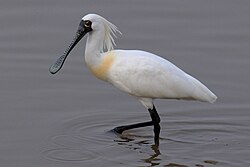Black-faced spoonbill
| Black-faced spoonbill | |
|---|---|
 |
|
| Scientific classification | |
| Kingdom: | Animalia |
| Phylum: | Chordata |
| Class: | Aves |
| Order: | Pelecaniformes |
| Family: | Threskiornithidae |
| Genus: | Platalea |
| Species: | P. minor |
| Binomial name | |
|
Platalea minor Temminck & Schlegel, 1849 |
|
The black-faced spoonbill (Platalea minor) has the most restricted distribution of all spoonbills, and it is the only one regarded as endangered. Spoonbills are large water birds with dorso-ventrally flattened, spatulate bills. These birds use a tactile method of feeding, wading in the water and sweeping their beaks from side-to-side to detect prey. Confined to the coastal areas of eastern Asia, it seems that it was once common throughout its area of distribution. It has a niche existence on only a few small rocky islands off the west coast of North Korea, with four wintering sites at Macau, Hong Kong, Taiwan and Vietnam, as well as other places where they have been observed in migration. Wintering also occurs in Jeju, South Korea, Kyushu and Okinawa, Japan, and the Red River delta in Vietnam. More recently, sightings of black-faced spoonbill birds were noted in Thailand, the Philippines, mainland China, and Macau They were classified as an endangered species through IUCN in 2000. Declines in their population are predicted in the future, mainly due to the amount of deforestation, pollution, and other man-made industries.
The black-faced spoonbill population in the 2012 census was recorded at 2,693 birds, with an estimation of 1,600 mature birds. Breeding colonies occur between March and August, on small islands. These birds are known to be crepuscular eaters, using intertidal mudflats.
Conservation efforts have been made, and surveys were taken in order to determine the opinions and awareness of the local residents, residing close to the black-faced spoonbill’s natural habitats. One survey taken by Jin et al. 2008, inquired upon the ‘Willingness-To-Pay” factor in the locals, as well as understanding effects on mandatory surcharges compared to voluntary payments.
A study of mitochondrial DNA of the spoonbills found that the black-faced and royal spoonbills were each other's closest relatives. Out of the six Platalea species within the family Threskiornithidae, the black-faced spoonbill is the rarest.
...
Wikipedia

